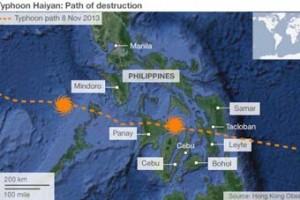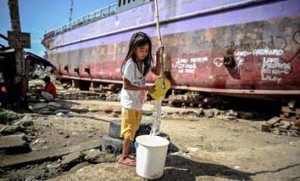Fifteen months after super typhoon Haiyan battered the Philippines, life on the devastated Visayan Islands struggles to return to normal, reports JAMES FRANCIS WARREN.
On 8 November 2013, the most powerful cyclonic storm on record to make landfall in the Philippine archipelago—Haiyan, named Yolanda in the Philippines—struck the Visayan Islands. Moving on a west-north-westerly trajectory, super typhoon Haiyan had maximum sustained winds of 315 km/h, and gusts of 379km/h when it swept in from the Pacific and hit exposed coastal fishing towns on the east coasts of Samar and Leyte.
With its brutal winds and resulting storm surge, the storm killed at least 6300 people and, at its peak, displaced more than 4.4 million residents and damaged 1.4 million homes. The World Health Organisation reported that, at the height of the disaster, over 398 thousand people were being housed in 1551 evacuation centres and that more than 600 health facilities had been damaged or destroyed.

On Leyte, the city of Tacloban and its environs were obliterated after catching the full force of the winds. But it was the storm surge that caused the heaviest damage and killed the most people. The surge coincided with a high tide, sending an enormous wall of water crashing through Tacloban’s low-lying areas and destroying nearly every building there, including the nearby airport.
Haiyan left a 600 kilometre-wide swath of destruction across the Visayan islands of Samar, Bohol and Panay. Most of the traumatised survivors spent their first few weeks sheltering in the ruins of destroyed buildings, or makeshift hovels. It was believed that in Tacloban alone, where hardly a building was left standing, 10 000 people died. Many already poor coastal fishing and farming communities in the central Visayas were destroyed.
In Guiuan, a fishing town of 40 000 people in eastern Samar, which was the first to be hit as Haiyan swept in from the Pacific, the damage was catastrophic—described by American meteorologist Jeff Masters as ‘perhaps the greatest wind damage any city on earth has endured from a tropical cyclone in the past century’.
Over a month later the unimaginable magnitude of the disaster continued to unfold. The United Nations announced that more than 14.9 million people had been affected, up to 5 million of them children. More than 4.3 million people remained displaced and the livelihoods of 2 million had been destroyed.
Given the enormous scale of the disaster, the overwhelmed, under-resourced and still shocked Philippine government faced huge constraints. Local medical infrastructure was gone, medical supplies had been washed or blown away, and many local health staff and first responders were either dead or unaccounted for.
The scale of the initial emergency became a logistical nightmare. Communication systems were offline, local and international rescue teams were unable to secure air and ocean transport to reach the more remote areas with essential supplies of food, water, medicine and shelter, and bad weather hampered relief efforts.
The lingering impacts of Haiyan have adversely affected the lives of millions of Filipinos and pushed them further into poverty
The Philippine government had always relied on the Red Cross and other members of the international community to provide relief and humanitarian assistance for typhoon-prone areas. But the disastrous impacts of typhoon Haiyan were unprecedented. The Philippines suffers an estimated $US1.6 billion in losses annually from calamities, but, according to environmental sociologist Tarique Niazi, Haiyan’s economic losses alone were valued at $US15 billion, or 5 per cent of the Philippine’s gross domestic product (GDP) of around $US300 billion.
The ongoing massive relief effort is expected to last for years as businesses, non-government organisations and charities help rebuild the worst-affected areas. Over a year later, more than 2.5 million people remain without proper housing. In addition, more than 100 000 displaced people are still living in unsafe coastal areas in temporary shelters made from tarpaulins or plastic sheeting.
Pyschosocial problems have increased as displaced communities and grief-stricken individuals struggle to restore their lives and livelihoods. The lingering impacts of Haiyan have adversely affected the lives of millions of Filipinos and pushed them further into poverty, with many still living in evacuation centres while having to continue to pay the mortgage on their destroyed homes.
In the central Philippines, there has been a constant struggle with the forces of nature and global capital to balance escalating production costs and tenancy arrangements of monocrop economies against diminishing livelihoods. That extreme weather should turn against Visayan farmers with such venom is a blow from which tens of thousands have found it difficult to recover.

Agriculture has reached a lamentable state in various typhoon-prone areas of the Visayas. Farmers are facing growing indebtedness and uncertainty about their future on the land, and if conditions of deprivation and social inequality continue to persist, there will be periodic starvation in the future.
Although the Tacloban economy appears to be recovering, several large typhoons since Haiyan have thwarted efforts to resuscitate the devastated farmlands, coconut plantations and fishing fleets of the regional economy. At the end of 2014, charities reported large numbers of indebted people leaving for Manila and other cities in search of work, including young women entering the sex industry to support their rural families.
Typhoon Haiyan also affected the national economy. In 2014, the Philippines experienced lower growth due to the fallout from the storm despite major reconstruction getting underway. The World Bank predicts the Philippine’s GDP will grow by 6.6 per cent—slightly lower than its pre-Haiyan economic growth forecast of 6.7 per cent.
Cyclonic storms have helped shape the character—physically, economically, socially and culturally—of particular regions of the Philippines. A well-developed culture of response to disasters, rather than a deeply embedded culture of mitigation, has existed among Philippine governments, donors and humanitarian organisations. But, in the aftermath of Haiyan, that kind of short-term thinking to strategic disaster management no longer prevails to the same extent.
Further government support and cross-sectoral cooperation are needed to expand the Philippines’s institutional and legal framework to ensure environmental sustainability and to manage the risk posed by these emerging super storms, which are likely to increase in intensity and size with global warming.
The effects of global warming—in particular an increase in cyclonic storms like Haiyan—offer a frightful warning not just for the Philippines but for the planet itself. As Tarique Niazi noted: ‘The cumulative losses in lives and livelihoods, homes and hearths, businesses and infrastructure have no parallel in Philippines history, just as Haiyan has no precedent in the annals of meteorology.’
Main photo:
Haiyan’s fury caused unprecedented economic losses (BBC News Asia).
